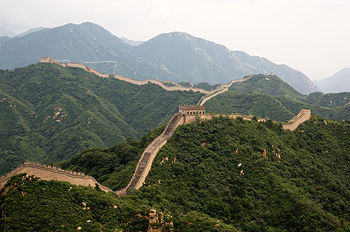Great Wall of China: Difference between revisions
imported>Derek Harkness (Qin dynasty wall) |
imported>Richard Jensen mNo edit summary |
||
| Line 2: | Line 2: | ||
[[Image:Great Wall of China.jpg|right|thumb|350px|{{#ifexist:Template:Great Wall of China.jpg/credit| | [[Image:Great Wall of China.jpg|right|thumb|350px|{{#ifexist:Template:Great Wall of China.jpg/credit| | ||
{{Great Wall of China.jpg/credit}}<br/>|}}A section of the Great Wall.]] | {{Great Wall of China.jpg/credit}}<br/>|}}A section of the Great Wall.]] | ||
The '''Great Wall of China''', known to the Chinese as The Long Wall of 10,000 Li ([[Pinyin]]: ''Wànlǐ Chángchéng'') is emblematic of China. This UNESCO World Heritage Site<ref>http://whc.unesco.org/en/list/438</ref> has a history which dates back over | The '''Great Wall of China''', known to the Chinese as The Long Wall of 10,000 Li ([[Pinyin]]: ''Wànlǐ Chángchéng'') is emblematic of China. This UNESCO World Heritage Site<ref>http://whc.unesco.org/en/list/438</ref> has a history which dates back over 2500 years. It is now a major tourist attraction in [[China]] with sections of the wall being restored for this purpose - especially near Beijing. The total length of the wall is unknown. Its size, age, complexity and general state of disrepair mean that new sections of wall are still being identified and some sections my yet await discovery. In its last incarnation, during the Ming Dynasty, the wall reached its zenith in building quality and length measuring 5,650 km<ref>http://whc.unesco.org/archive/advisory_body_evaluation/438.pdf</ref> and crossing 17 provinces in North and Central China. | ||
==History== | ==History== | ||
| Line 10: | Line 10: | ||
<!-- Qin Dynasty, Han Dynasty, Disuse during Yuan Dynasty, Ming Dynasty, Disuse during Qing dynasty, Modern restorations and reconstructions. | <!-- Qin Dynasty, Han Dynasty, Disuse during Yuan Dynasty, Ming Dynasty, Disuse during Qing dynasty, Modern restorations and reconstructions. | ||
The wall's construction began during the Warring States Period, which lasted from 403 to 221 BC. Qin Shi Huang, establisher and first emperor of the Qin dynasty, erected the largest portion of the wall as a defense against attacks by nomadic peoples. Real work on the wall began in 221 BC, after Shi Huang had united China under his rule, and it was finished in 204 BC. Small sections of the wall already existed, but Huang had nearly 2,000 km of the wall built during his reign. More than 300,000 men worked connecting the segments into a single, huge wall of stone and earth.--> During the Ming Dynasty of 1368 to 1644 AD, interest in the Great Wall was revived, and it was repaired and extended, this time reinforced with cement and stone. <ref>http://www.paulnoll.com/China/Tourism/history-Great-Wall-1-beginning.html</ref> | The wall's construction began during the Warring States Period, which lasted from 403 to 221 BC. Qin Shi Huang, establisher and first emperor of the Qin dynasty, erected the largest portion of the wall as a defense against attacks by nomadic peoples. Real work on the wall began in 221 BC, after Shi Huang had united China under his rule, and it was finished in 204 BC. Small sections of the wall already existed, but Huang had nearly 2,000 km of the wall built during his reign. More than 300,000 men worked connecting the segments into a single, huge wall of stone and earth.--> During the Ming Dynasty of 1368 to 1644 AD, interest in the Great Wall was revived, and it was repaired and extended, this time reinforced with cement and stone. <ref>http://www.paulnoll.com/China/Tourism/history-Great-Wall-1-beginning.html</ref> | ||
see also [[China, history]] | |||
==References== | ==References== | ||
<references /> | <references /> | ||
Revision as of 21:57, 7 December 2007
The Great Wall of China, known to the Chinese as The Long Wall of 10,000 Li (Pinyin: Wànlǐ Chángchéng) is emblematic of China. This UNESCO World Heritage Site[1] has a history which dates back over 2500 years. It is now a major tourist attraction in China with sections of the wall being restored for this purpose - especially near Beijing. The total length of the wall is unknown. Its size, age, complexity and general state of disrepair mean that new sections of wall are still being identified and some sections my yet await discovery. In its last incarnation, during the Ming Dynasty, the wall reached its zenith in building quality and length measuring 5,650 km[2] and crossing 17 provinces in North and Central China.
History
The principle of building large walls to protect regions of territory in China can be traced back to the Chunqui (722-481 B.C.) and the following Warring States Period (403-221 B.C.). These were times when several large dynasties competed for control over what would later become China. The conflicts between these rival kingdoms explains why such defensive walls were built. One such example is the wall built in 408 B.C. to defend the Wei kingdom form their agressive Qin neighbours. A large number of walls were build by each of the Qin, Zhou and Yan kingdoms throughout the 3rd century B.C. to defend agains barbarians form the north and also to protect themselves form each other. The Qin, under the leadership of Emperor Shi Huang in 220 B.C., unified China into a single state. The Emperor directed further wall construction to defend the north of his new empire. Rather than the mamoth single construction feat that is often portraid, this project was more like joining the dots, connecting together and repairing the existing walls to make a unified defensive line. The patchwork of pre-existing walls streached form the regiod of Ordos in the west to Liaoning in the East. The Qin filled in the gaps and extended the line of the wall westward form the Huanghe valley as far as Lanzhou. In total, 2000 Km of wall was constructed during the Qin Dynasty's short rule and employed 300,000 men in the process.
During the Ming Dynasty of 1368 to 1644 AD, interest in the Great Wall was revived, and it was repaired and extended, this time reinforced with cement and stone. [3]
see also China, history
